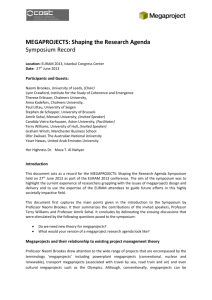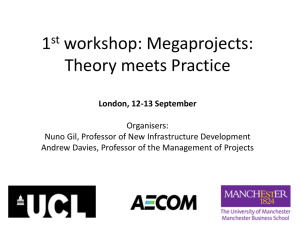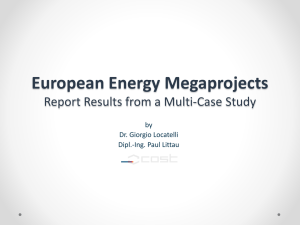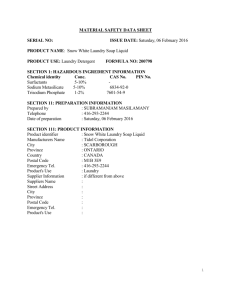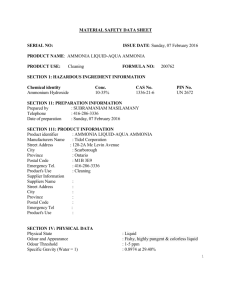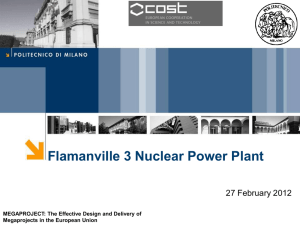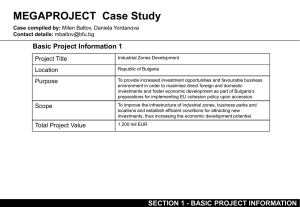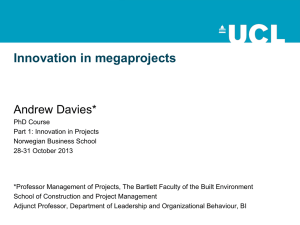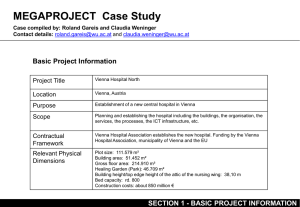link
advertisement
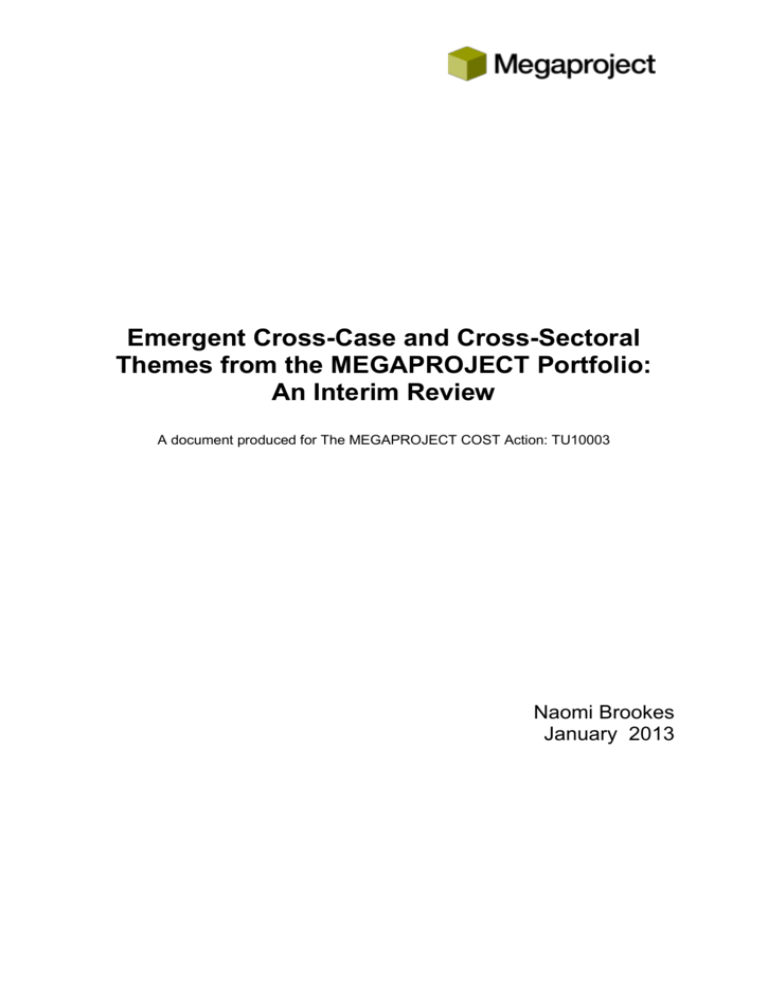
Emergent Cross-Case and Cross-Sectoral Themes from the MEGAPROJECT Portfolio: An Interim Review A document produced for The MEGAPROJECT COST Action: TU10003 Naomi Brookes January 2013 Emergent Cross-Case and Cross-Sectoral Themes from the MEGAPROJECT Portfolio Introduction and Aim The aim of this monograph is to bring together the diverse work streams that have been undertaken within the MEGAPROJECT COST Action. Its aim is to identify cross-case themes that emerge from the behaviour of the megaprojects in the MEGAPROJECT case portfolio. These themes are then triangulated to establish meta-themes that relate to the whole of the MEGAPROJECT portfolio across sectoral boundaries. This paper follows the initial work published in “MEGAPROJECT Cross- Case Themes: An Initial Examination” produced in April 2012. Existing Work Streams The following represent the work streams carried out under the auspices of the MEGAPROJECT COST Action to establish cross-case themes: The Cross-Sectoral Working Group’s Activities The Transport Working Group’s Activities The Energy Working Group Activities o Initial Review o Inductive and Deductive Approaches o Semantic Analysis o Non-Parametric Statistical Analysis Approach to verification The Transport Working Group Activities The non-parametric statistical analysis of the whole MEGAPROJECT portfolio The MEGAPROJECT Training School and Think Tank held on 30/11/12 – 2/11/12 A Short-Term Scientific Mission undertaken between Robert Hickey and Professor Mauro Mancini at the Politecnico di Milano All of these work streams have produced individual reports that are available from the MEGAPROJECT Project Executive, Sarah King, at info@mega-project.eu. This monograph has used these reports in its construction. The Cross-Sectoral Working Group Activities These activities have been coordinated through two working group meetings: one held at the last Whole Action Workshop in Bratislava and one held in Edinburgh in September. Emergent cross-case themes and potential hypotheses were identified through a brainstorming process and the results of this are presented in the table below. Origin of Thematic Finding Cross-Sectoral Working Group Thematic Finding EMERGING THEMES Designing megaprojects – the differences depending on the starting points, with some of them renewals of former projects, some running for years and changing and some with purely new start Designing megaprojects – the difference related with the type of investments and Page 2 of 15 management, some fully private, some fully public and those most difficult with a combination of public and private money and/or management of the process Defining the project value and the different incentives to it The relation between the complexity, predictability, goals and objectives in a megaproject The accessibility of data on the a megaproject Regulations and limitations when a megaproject is financed under a EU funds (programmes like Jessica and the ERDF projects) Contractual agreements in the megaprojects and their specifics in the time and decision making Clear definition of a business model, influencing the final outcomes (products) of it Risk management challenges with megaprojects Identifying the performance “gap” between the majour projects and the mega projects – possible implications on the EU terminology Evaluation tools application to mega projects – the specifics of the Cost Benefit Analysis The models of technology parks design and development – comparative analysis between Scandinavian and South-East European practices POTENTIAL HYPOTHESES(not proven) ‘Heavy’ Front End: Sound planning leads to successful megaproject performance A clear definition of the business model of the megaproject leads to successful megaproject performance Early involvement of the supplier network leads to successful project performance A correct balance between strong leadership and participative leadership leads to successful megaproject performance. Dealing with Uncertainty: Project management can not avoid uncertainty Complex Multi-Programs: Business models of products have impact on project performance Institutional Impact: Hypothesis Good balancing of strong leadership and stakeholder participation has a high impact on project success Table 1: The Cross-Sectoral Working Group’s Thematic Findings The Transport Working Group’s Activities These activities have been coordinated through two working group meetings: one held at the last Whole Action Workshop in Bratislava and one held in Brussels in November. The Transport Working Group has used the work of the Energy Working Group as a ‘seed’ to brainstorm further hypotheses that relate megaproject performance to its characteristics. The working group aims to adopt a ‘fuzzy logic’ approach to ratifying these hypotheses and is, to this end, devising a range of granulations and scaled linguistic variables to describe each of these granulations. These are provided in Annex A of this monograph. As of yet, these hypotheses have not been empirically tested. The Energy Working Group’s Activities The Energy Working Group began the initial construction of a set of cross-case themes in its Working Group meetings in the first Year of MEGAPROJECT’s operation. This work has Page 3 of 15 been further developed and coordinated through two working group meetings: one held at the last Whole Action Workshop in Bratislava and one held in Milano in July 2012. Three processes were investigated to generate cross-case themes: An inductive process inspired by Eisenhardt’s work(Eisenhardt 1989) A deductive approach based on operationalising hypotheses (generated by a brainstorming process) and verifying these through the case portfolio A semantic based rule elicitation and validation process The processes used for the first two of these approaches are illustrated in the figures below : Figure 1: ‘Operationalising Brainstormed Hypotheses’ Approach Figure 2 Inductive Approach to Hypothesis Generation Page 4 of 15 The relative advantages of deductive and inductive approaches are discussed in the MEGAPROJECT Monograph entitled “Inductive and Deductive Theory Generation from Case Studies: The Experience of the MEGAPROJECT COST Action” produced in August 2012. The inductive approach did produce additional propositions to those generated through the deductive approach. These propositions were then operationalised into a series of formal hypotheses which were tested using the Fisher Exact test to examine if they were (or were not) supported by the MEGAPROJECT Energy Portofolio. This process was then replicated for the whole of the MEGAPROJECT portfolio and is described in this context in more detail elsewhere in this monograph. A semantic based rule elicitation and validation process was carried out using the following phases : Semantic clustering of individual brainstormed propositions to derive from these a set of clusters, with attached concise statements (typically of a maximum of twenty words) reflecting most of the ideas in each cluster. This was done manually for the purposes of MEGAPROJECT but would normally be performed by automated linguistic analysis tools. These semantic aggregated clusters become hypothesis, Hypothesis validation where each case was assessed by each author checking whether each case satisfied either in binary terms (i.e. Yes/No) or insome form of percentage evaluation/in. (In this phase It wasmandatory that all completed cases were included.) Then an average (with spread) hypothesis validity (from the case sample base ) was computed for each hypothesis across the case sample. (In this phase hypotheses with over 50 % validation are frozen and become rules; those with less than typically 50 % validation are normally discarded, or the hypothesis is refined, and the process starts over again untill convergence on a stable small set of revised hypotheses with all >50 % validity.) Group rule validation was performed at the end, to avoid that the accepted rules are not just "motherhood statements" . (This is normally achieved by sending back the set of rules to all case authors asking them if that *set of rules* has jointly covered eg. at least 75 % of the general and specific issues in each case.) This approach produced two semantic based ‘rules’ for MEGAPROJECTS which are contained in Table 2 below. (Successive refinements and increments could have been continued.) Table 2 also contains summaries of the propositions generated by the other Energy Working Group activities. Activity Initial Milano Meeting Thematic Finding The more unemployment in the megaproject’s local environments, the less resistance to it from local residents. (H, M) The more local residents perceive property values to increase/decrease, the less/more resistance to the megaproject. ( D, H) The more spending by the megaproject on the local community, the less the resistance to the megaproject ( A, H, M) The more trust the general population has in regulators, the less opposition to megaprojects ( F, H) The successful completion of a megaproject requires a specific articulation of national government support ( M, H, G) The more ‘mega’ the megaproject, the more difficult to identify the stakeholders and the more likely for the stakeholders and their needs to change during the lifecycle of the megaproject (M,H,A,M,G,F) The more innovative the megaproject, the more likely to fail to meet iron triangle success criteria (supporting proposition G, F not supporting proposition A) Page 5 of 15 SIMILARITIES IN MEGAPROJECTS Formation of project based organisations (H,G, A, M?) There is frequently a joint venture organisation ( often an equity joint venture) formed between organisations to be the client/owner for the megaproject. The degree to which this is a ‘real’ organisation ( staffed with people and with project management responsibility) or a ‘ghost’ organisation ( not staffed with the project activities still being undertaken by the owners varies. Financing of Megaprojects ( H,G,A, M) Most megaprojects are financed by consortia of organisations and not by a single organisation. Similar Patterns of Actors (H,G,A,F,M,D) Energy Megaprojects in Europe have a similar pattern of stakeholder actors and those actors are often act in the same capacity across a number of cases: Owners (either directly or of temporary project organisation): TransEuropean Energy Companies with a substantive state ownership, e.g. E-ON, RWE, EDF, ENEL Prime contractors: Turbo-machinery ( Siemens, Rolls-Royce, Alstom); Nuclear Steam Systems (Arreva); EPC ( Aker, Fluor, AMEC, Saipem Optimism Bias (G, H, F, A?) Energy Megaprojects do demonstrate optimism bias in the forecasts of leadtime and costs for completion but the reason for this is not clear. (It does not seem to be for reasons of misrepresentation to create a business case c.f. Flyvbjerg) Lack of Scope Changes (G,H, A,F,D?) Energy megaprojects don’t seem subject to scope creep (e.g. target for MWe seems to remain the same throughout the project) Semantic Based Rule Elicitation Similarities in Scale (G,H,A,F) Energy megaprojects in Europe seem to be of a similar scale. They take about 10 years from the first project idea to full operation. They involve a peak of 3000-5000 in construction. The y cosy €2bn-€7bn Good management and good outcomes on projects are correlated. Links and incentives must be created for success for the different categories of Users and Builders Table 2: The Energy Working Group’s Thematic Findings The MEGAPROJECT Training School and Think-Tank The first MEGAPROJECT Training School and ‘Think-Tank’ was held in Leeds on November 30th – December 2nd 2012. This event had dual aims: To develop the skills in cross-case analysis of Early-Stage Researchers(ESRs) involved in the project To use these skills to review the whole of the MEGAPROJECT portfolio to identify emergent themes. To this end, the ESR’s were divided into four groups and each tasked with giving their view on emergent themes in the MEGAPROJECT portfolio. Each team produced an individual report summarizing their perspective on emergent themes and the process that they used to Page 6 of 15 establish these. Individual reports are available from the Project Executive, Sarah King, at info@mega-project.eu. The emergent findings of each group are summarized in the table below along with additional comments. It is to be noted that all groups found the construct of ‘project success’ as difficult to operationalise in a unitary fashion. Group Group A Thematic Finding the presence of only one major stakeholder is related to a delay in construction and project and costs the megaproject having national public acceptability (no protest at the national) is associated with the project being on budget the mega-project fitting into the long-term plan of the country’s government is associated with no delay in construction and the project no going over budget. Comments Difficulty of success/failure as a construct Need for a ‘mediating factor’ to explain the results (see diagram below But evidence is not conclusive Group B Group C Group D Increasing prices of equipment/technology impact upon cost Environmentalist groups delay projects and have impact on cost Additional requirements of authorities increase costs Good stakeholder management has a positive impact on performance Congruency between needs (e.g. needs of community) and project goals improves performance Congruency between political goals (e.g. change in environmental law) and project goals improves performance The typology of contract doesn’t affect the project acceptance. Stakeholder network complexity always occurs (megaprojects are complex by definition), but seems to have no so much impact on project acceptance. Project output performance (understood as Time, Cost , Quality) seems to be always weak but have no so significant impact on project acceptance Environment conditions (understood as legal, political as economic) have not much impact on project acceptance. Project ‘success’ is a problematic construct therefore derived a new performance characteristic , ‘project acceptance’ Tentative links surrounding local stakeholder involvement Table 3 The Training School’s Thematic Findings Short Term Scientific Mission(STSM) hosted by Professor Mauro Mancini at the Politecnico di Milano. The Short-Term Scientific Mission (STSM) was undertaken by Robert Hickey of the International Business School in Bulgaria in June 2012 Its aim was to develop the work of the Energy Working Group in a cross-case analysis for the MEGAPROJECT portfolio and to understand the implications for using it more widely in the MEGAPROJECT Action. This included: Page 7 of 15 Laying the groundwork for testing the hypotheses and questions posed during the Energy Working Group brainstorming session, by identifying related project characteristic information that is needed to test the validity of the hypotheses for the megaprojects in the energy and cross-sectoral case studies. It also included adding hypothesis, questions and potential lines of analysis for determining success factors for megaprojects. Reflecting on the implications of the energy theme methodology to the cross-sectoral case studies. Identifying methodologies that would help identify cross-case themes in the Megaprojects case studies through the development of a bibliography. The findings of the STSM are contained in a separate report produced by Robert Hickey and are summarised in Table 4. A table was designed to capture if a relationship between a postulated construct and megaproject performance could be viewed as positive or negative, weak or strong, or unconfirmed. The process was based on approaches to capturing MEGAPROJECT performance derived by Merrow (2011). Constructing the table highlighted the need to return to the original cases and to supplement them. Thematic Finding Off-site construction is associated with cost overruns Highly innovative projects are associated with cost over-runs Less spending on the local community is associated with slips in schedule The passage of unforeseen regulations is associated with schedule slippage Changes in ownership structure are associated with schedule slippage Decreases in local property values as a result of a megaproject are associated with schedule slippage. Table 4: Thematic Findings of the STSM The non-parametric statistical analysis of the whole MEGAPROJECT portfolio As a development of the work of the Energy Working Group, Giorgio Locatelli assisted by Naomi Brookes and Sarah King, undertook an analysis to ascertain statistically significant relationships between megaproject characteristics and megaproject performance. An overview of this activity is contained in a power-point presentation and is obtainable from the Project Executive, Sarah King, at info@mega-project.eu. The operationalised MEGAPROJECT characteristics derived by the Energy Working Group were used to code the remainder of cases from the MEGAPROJECT portfolio. These characteristics were operationalised in a binary fashion (i.e. either present or not present). These characteristics are shown in Table 5. Brainstormed Megaproject Characteristics Project has a foreign EPC company Siemens is involved as a contractor in the project There is a presence of one major stakeholder The EPC has a clear goal The project is mono Cultural Page 8 of 15 More than 50% share of the client is under government control An experienced project director is present Green Peace or other international environmental activists have been involved in the project The project has national public acceptability (no protest at national level) The project has local public acceptability (no protest at local levels) Environmental activists and regulators have been engaged ex-ante, not ex post Local communities had a conservative attitude to development Investment on external communication was above 0,01% of the total budget The project has a strong regulation system as evidenced by: a) The authority stopped the project or similar projects in the same country b) The authority give fine to the EPC (main contractor) or one of the internal stakeholders in the project c) The project start has been delayed by the authority The project fit in the long term plan of the country's government There is planned a long term stability in usage and value The project enjoys political support as evidence by: a) Support of the central government b) Support of the local government The megaproject is decomposed in many sub-projects which can use the learnings from other project Heavy usage of planning by milestones Heavy usage of Formal project management tool and technique Usage of performance metrics Client and Owner are different Turn key contract between Client and EPC (main contractor) There is a formal litigation procedure (e.g. international chamber of commerce) between Client and EPC Project has a high quality feasibility study Project has a well developed FEED Modular project - consider only the related sentences below a) The project is modular - dependent modules b) The project is modular - independent modules High level of technical innovation FOAK (First Of A Kind) or unique Project (like Venezia mose) Tough environmental condition (dangerous local situation) Tough physical or environmental conditions Financial Support from the European Union Financial Support from the national government National Public Acceptability Local Public Acceptability Local residents were involved in the project Previous national similar project was successful Unemployment in the area above national average The population trusts the regulatory authority. The Compensation of local community above 0,1% of the total budget The density of population of the province is below the national average The project is nuclear Table 5: Brainstormed Characteristics that Affect Megaproject Performance Page 9 of 15 An attempt was then made to relate the presence (or absence) of these characteristics (independent variables) with the performance of the megaproject (dependant variables). Initially megaproject performance was viewed as either being a ‘success’ or a ‘failure’ but this was found to be an opaque and too simplistic characterization. Instead performance was characterized in terms of cost compared to the original budget, delays in the planning stage and delays in the construction phase. Again these were considered as ‘binary’ characteristics that were either present or not present in the case. Through this mechanism, 2x2 contingency tables for each characteristic and each performance element were created. The resulting dataset was therefore amenable for analysis using the Fisher Exact Test. (More information on this can be obtained from the texts in the bibliography at the end of this monograph) This test was used to ascertain if any relationship existed between any of the characteristics of a megaproject case and the performance of that megaproject. This test was implemented using the HYPGEOMDIST function in Excel which is used to compute probabilities under a hypergeometric distribution. The completed Excel spreadsheet used to undertake this analysis is available from the Project Executive at info@mega-project.eu. Given the nature of the relationship being sought, a very much higher p-value (0.25) was used to judge if a relationship between independent and dependant variables was statistically significant. This was justified on the basis that practitioners and researchers alike would be interested in strong indications of the presence of relationships rather than requiring ‘certainty.’ On this basis, megaproject characteristics that have been demonstrated to have a statistically significant relationship with mega-project performance are given in the table below: Impact on Project Performance Megaproject Characteristics WILL CAUSE DELAYS IN THE PLANNING PHASE - WILL CAUSE DELAYS IN THE CONSTRUCTION PHASE - WILL ENABLE THE CONSTRUCTION PHASE TO BE ON TIME WILL CAUSE PROJECT TO BE OVERBUDGET WILL ENABLE THE PROJECT TO BE ON BUDGET - Large-scale use of formal PM techniques Project has a well-developed FEED Density of the population in below national average Project has a foreign EPC company Involvement of Environmental Activists The project is a Nuclear New Build Project has a well-developed FEED Large-scale use of formal PM techniques Support of central government Presence of one major stakeholder The project is mono-cultural Financial support from the EU Financial support from central government Table 6: Statistically Significant Relationships between Megaproject Characteristics and Megaproject Performance It is to be noted that a substantial majority of brainstormed characteristics displayed no statistically significant relationship at all. Furthermore, these findings should be treated with caution. Performance was not measured absolutely but in terms of achievement to forecast. In other words, a project that marginally fails to meet a tight timescale would be considered to have performed more badly than a project that meets a very lax timescale. Page 10 of 15 Identifying Emergent Cross-Sectoral Themes This monograph has shown twelve approaches to developing cross-case themes. Five of these have been concerned with looking at cross-case themes within a particular sector of the portfolio and seven approaches have been concerned with identifying cross-sectoral themes. (This calculation has identified four distinct approaches adopted by the groups at the Training School). In order to use these findings to make a tentative and initial identification of cross-sectoral themes, a process of triangulation has been used. Triangulation, in social science research methodological terms, allows for verification of postulated relationships through several different approaches performed by different researchers at different points in time arriving at the same conclusions (Gill and Johnson 2010) The findings of each of the distinct workstreams have therefore been compared and used to identify common thematic grouping of issues that have been considered to have an effect on megaproject performance. (The hypothesised fuzzy relationships of the transport Group were not used as these had not yet been tested empirically). These are summarised in Table 7 below: Fisher Exact Test Analysis Group D Group C Group B X X X X X X Financial and contractual structure Business models Joint venture structures Social networks Internal stakeholder structures Regulatory include: and Political Environment Support of Central Government Support of EU Unexpected Regulatory Changes Use of FEED and other planning initiatives Early supply network involvement Use of formal PM Techniques to X Project Management Approaches to include: Technological include: X X X X X X Local community characteristics (wealth, degree of unemployment, property values etc.) Expenditure on external stakeholder management Difficulty of stakeholder identification Incentives for stakeholder users Governance and Structure to include: X Group A X Training School/Thi nk Tank SSTM Semantic Analysis External stakeholder management to include: Energy WG Initial Investigation Cross-Sectoral WG Megaproject Characteristic Grouping novelty and complexity X X X X to X X X X X Technological complexity and its interactions with project objectives Table 7: Emergent Thematic Groupings that Influence Megaproject Performance Page 11 of 15 It is interesting to note that the same issue is perceived as having different results by different workstreams. For example, the Fischer Exact test indicates that the use of formal project management tools is inimical to megaproject performance whereas the CrossSectoral group’s work indicates that they postulate that formal project management tools improve the success of megaprojects. References Eisenhardt, K. M. (1989). "Building theories from case study research." Academy of Management review: 532-550. Merrow E. (2011) "Industrial Megaprojects: Concepts, Strategies, and Practices for Success" Wiley, NY Gill J. and Johnson P. (2010) "Research Methods for Managers" Sage Bibilography Chris Leach: "Introduction to Statistics: A Nonparametric Approach for the Social Sciences" ISBN-13: 978-0471997436 Jenny V Freeman and Michael J Campbell "The analysis of Categorical data:Fisher’s exact test" http://www.sheffield.ac.uk/polopoly_fs/1.43998!/file/tutorial-9-fishers.pdf Annex A: Transport Working Group's Fuzzy Propositions Themes External Stakeholders Themes statements Qualitative scale Involvement of environmental groups/activists None - no involvement at all (1) - total - involved in project stage(5) Was the involvement generally supporting the project or against it? no(0)-yes(1) The project has national public acceptability (no protest at national level) none (1) - total support (5) The project has regional public acceptability (in the region or regions where the project is located) none (1) - total support (5) Exposure in the media Easiness of access to relevant information for stakeholders Perceived impact at the local communities Is there a professional public relation initiatives in the project Was there any public mood change during the project implementation phase (from planning, design to construction) Page 12 of 15 mainly negative (1) - mainly positive (5) none (1) - complete availability of documents and studies (5) Totally negative (1) - totally positive (5) none (1) - extremely comprehensive public relations initiaves (5) from positive to negative (1) from negative to positive(5) Internal stakeholders After the project started operation the public mood about it changed? from positive to negative (1) from negative to positive(5) The Project has a foreign EPC consortium totally local (1) - totally foreign image and perception (5) There is a presence of one major stakeholder (contractor) no(0)-yes(1) Is there a clear scope throughout the project to all concerned No clear scope and changeable (1) - completely clear and stable scope(5) The project is mono Cultural (business culture) no(0)-yes(1) Is there an identifiable project culture More than 50% share of the client is under goverment control An experienced project director is present no(0)-yes(1) Is there a cooperative relation between the client and contractor(s) Is there any political support/agreement about the project level of priority Where there changes in scope due to political action? Political pressure related with milestones deadlines Political Project Environment Legal Project environment no(0)-yes(1) no(0)-yes(1) No(1)- All main parties are completely supportive (5) no(0)-yes(1) no(0)-yes(1) Positive political support depending on degree of external funding no(0)-yes(1) The project is on the TEN-T no(0)-yes(1) Evidences of polititians being too sensitive to pressure groups no(1)- clear evidences of changed decisions due to pressure (5) Are there evidences that "democratic" process is resulting in project delays (appeals)? no(0)-yes(1) Stable legal environment (withouth any major changes in the legislation during the process time) no(0)-yes(1) Changes in legislation relative to tendering processes Changes in legislation relative to environmental law There was a stable economic environment during the project implementation phase Changes in the economic impact during the operational phase Changes in energy prices Economic Project Environment no(0)-yes(1) New operators/modes (competetitors) entering in the market during the implementation phase New operators/modes (competetitors) entering in the market during the operation phase Operators/modes (competitors) leaving the market (or extremely reduce their operation) during the operation phase Page 13 of 15 n0(1) - extreme changes which completely overturned the previous process(5) n0(1) - extreme changes which completely overturned the previous process(5) absolute stability(1)-extreme changes(5) absolute stability(1)-extreme changes(5) absolute stability(1)-extreme changes(5) no(0)-yes(1) no(0)-yes(1) no(0)-yes(1) Financial Support from the European Union Financial Support from the national governament no(0)-yes(1) no(0)-yes(1) Valid CBA considered or not no(0)-yes(1) LCC was considered or not Is there any evidence of a general "optimistic bias" in the project The procurement processes are transparent? Risk analysis related with schedules and costs Risk analysis related with project results (demand forecasts) Existence of sensitivity analysis Apointment of a dedicated project manager in the team Project Management Level of competenced of the project management team Are cost deviations analyzed and documented The megaproject is decomposed in many subprojects There was an effective learning process from other projects and(or) tasks in the same project Project Impacts no(0)-yes(1) no(0)-yes(1) no(0)-yes(1) low, only technical background(1) -high, internationally proven compentence in PM(5) no(0)-yes(1) no(0)-yes(1) no/feeble(1)- important lessons learned and applied(5) Heavy usage of planning by milestones no(0)-yes(1) Heavy usage of Formal project management tool and technique no(0)-yes(1) Usage of performance metrics no(0)-yes(1) Client and Owner are different Turn key contract between Client and EPC (main contractor) There is a formal litigation procedure (e.g. international chamber of commerce) between Client and EPC no(0)-yes(1) High level of technical innovation Technology no(1) - consider all LCCosts in all the project aspects/domains(5) no(1) - there is strong evidence of optimistic bias in all the forecasts made for the project(5) no(0)-yes(1) no(0)-yes(1) Using untried technology or materials (not previously used) Appearence of relevant new technologyes during the project implementation (planning, design, and construction) no(0)-yes(1) no(0)-yes(1) no (0), incremental Innovation(1), disruptive innovation (5)- see OECD definitions no(0)-yes(1) no(0)-yes(1) Appearence of relevant (for competitors) new technologyes during the project implementation (planning, design, and construction) no(0)-yes(1) Tendering process favouring innovation no(0)-yes(1) Where there relevant unforeseen impacts? no(0)-yes(1) Page 14 of 15 Regional/national strategy (coherence) Not Classified Whas initially a coherence with a regional/national strategy as shown by official documents? no(1) - absolute coherence between objectives(5) Did changes in scope during the project implementation put in jeopardy this scoherence? no(1)- resulted totally incoherent(5) Did changes in the national/regional strategy put in jeopardy this coherence? no(1)- resulted totally incoherent(5) Tough physical or environmental conditions no(0)-yes(1) Page 15 of 15
